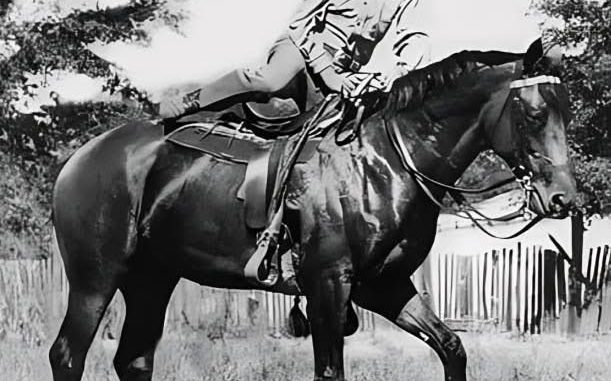
A rare image has surfaced, showing Charles Howard, the visionary owner of Seabiscuit, standing proudly alongside the legendary racehorse in their later years. For fans of horse racing and American history alike, the photograph is more than just a portrait of man and animal—it is a symbol of resilience, determination, and the unbreakable bond that defined an era.
Seabiscuit’s story is etched into the fabric of American sporting history. During the dark days of the Great Depression, when the nation was in desperate need of hope, a small, overlooked thoroughbred became a household name. Seabiscuit was never bred to be a champion. Undersized and dismissed early in his career, he carried with him the reputation of being stubborn and slow. Yet under the guidance of owner Charles Howard, trainer Tom Smith, and jockey Red Pollard, the horse would go on to defy every expectation, lifting the spirits of millions in the process.
Charles Howard himself was no stranger to reinvention. A self-made businessman who first found success as a Buick dealer in California, Howard had an eye for opportunity and a belief in second chances. When he purchased Seabiscuit in 1936, few could have imagined the remarkable partnership that would follow. To many, Howard was not simply a wealthy owner—he was a dreamer who recognized the potential in an unlikely horse, a quality that resonated with everyday Americans struggling through economic hardship.
The rare image captures the quiet intimacy between Howard and Seabiscuit in their later years, long after the horse had retired from racing. It is a reminder that Seabiscuit’s legacy was not built solely on his victories, but also on the deep connection between man and horse. The photo shows a gentleness in Howard’s expression, reflecting gratitude toward the animal that changed his life, and perhaps even America’s outlook on perseverance.
On the racetrack, Seabiscuit’s exploits became the stuff of legend. His most famous moment came in 1938 at Pimlico Race Course, in a highly anticipated match race against Triple Crown winner War Admiral. In front of a roaring crowd and a nation glued to their radios, Seabiscuit charged past his rival in decisive fashion. It wasn’t just a victory—it was a cultural moment, one that symbolized the triumph of the overlooked against the privileged, the working man’s fight against the odds. Newspapers across the country hailed the victory, and Seabiscuit became a national hero almost overnight.
For Howard, that race was more than a sporting achievement. It cemented his belief in Seabiscuit’s ability to inspire. In a time when unemployment and uncertainty plagued millions, the story of a small, underestimated horse rising to greatness gave people something to believe in. Seabiscuit’s underdog story mirrored the struggles of the American people, making his victories feel like personal triumphs for everyone who tuned in.
After retiring in 1940, Seabiscuit lived out his days on Howard’s Ridgewood Ranch in Northern California. There, he became a symbol of tranquility, often visited by fans who wanted to catch a glimpse of the horse that had once electrified the nation. Howard made sure Seabiscuit’s retirement was comfortable and dignified, evidence of the respect he held for the horse that had given him—and the country—so much.
The bond between Howard and Seabiscuit extended beyond business or sport. It was a partnership rooted in trust, loyalty, and mutual redemption. Howard had faced personal tragedies, including the devastating loss of his son in a car accident, and Seabiscuit himself had endured years of being written off before finding his stride. Together, they healed, thrived, and forged a narrative that transcended horse racing to become an American parable of hope.
Today, the rare image serves as a poignant reminder of this enduring story. In a world that often forgets the heroes of yesterday, it rekindles the memory of a man and a horse who changed the face of racing and inspired a nation. Their tale reminds us that greatness can emerge from the most unexpected places, and that sometimes, the strongest victories are won not just on the track, but in the hearts of those who believe.
Charles Howard and Seabiscuit remain forever linked, not only by racing glory but also by the quiet companionship evident in that photograph. It is a legacy of resilience and unity that continues to inspire, proving that underdogs can, indeed, become legends.
Would you like me to style this like a modern news article for an online sports/history site (with subheadings and quotes), or keep it in this more narrative, magazine-style flow?
Leave a Reply